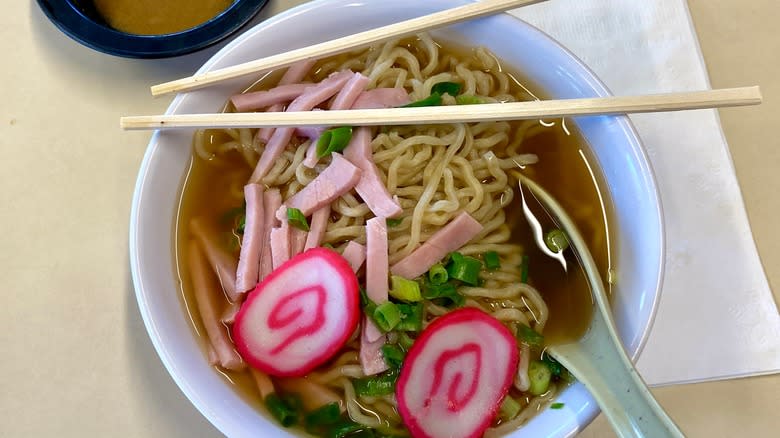Ramen Enthusiasts Will Love The Hawaiian Noodle Dish Saimin

The Hawaiian archipelago is among the most beautiful and distant groups of islands on Earth. Its uniquely remote location places Hawaii nearly halfway between Asia and America, leading to a blend of both Asian and American cultural influences. Modern Hawaiian cuisine is likewise a combination of Eastern and Western influences, with favorites like loco moco, spam, and pork hash — and another Hawaiian staple, saimin, that fuses various Asian culinary traditions with Hawaiian-American modifications.
Similar to Japanese ramen, saimin is a noodle soup consisting of a dashi-based broth, wheat noodles, and toppings. But unlike ramen noodles, saimin uses egg noodles with a softer texture and less curly appearance. Saimin's dashi-broth is also subtle and light, while toppings take inspiration from Japanese, Chinese, and American influences with ingredients such as spam, char siu, kamaboko, nori, and tamago. Newer versions of this soup may add dried shellfish, dried shiitakes, pork bones, and chicken stock to the broth; the toppings list has also expanded to include everything from radish, corn, and mushrooms to shrimp tempura, kalua pig, cabbage, jammy eggs, and crunchy wontons.
Just like ramen, saimin is customizable, rich with umami flavors, and available in nicer restaurants as well as fast food joints and convenience stores. At one point, you could even find it on the local McDonald's menu! If you love ramen, saimin is the perfect Hawaiian iteration you need to try.
Read more: 44 Types Of Pasta And When You Should Be Using Them
Saimin's History And Cultural Significance

Exactly how saimin became the amalgamation of Japanese, Chinese, and Filipino cuisines it is today is a story of decades-long culinary evolution. The dish became prevalent with the influx of Asian immigrants working Hawaii's sugar and pineapple plantations during the 19th century; the first public mention of saimin in the 1917 Honolulu Star-Bulletin calls it a Chinese dish. In fact, the name saimin is a derivative of Cantonese words meaning "thin noodles."
Both Chinese and Japanese peddlers were observed to sell saimin from food stalls during the early 1900s. As saimin gained popularity among Asian settlers, Americans, and Polynesians alike, stalls turned into restaurants. By the mid to late 20th century, saimin had become a staple at many local fast food and fine dining restaurants. Today, you can buy instant saimin soups in 7-Elevens and grocery stores.
As with ramen, saimin comes in both soup and dry noodle varieties, further pointing to Chinese and Filipino influences. Most saimin restaurants offer dry saimin, also known as dry mein, as a nod to Chinese chow mein, consisting of boiled saimin noodles topped with traditional saimin toppings. Another variety is fried saimin, or stir-fried saimin noodles with traditional toppings that parallel both Chinese and Filipino noodle stir-fries. But any version is certainly worth a try if you're craving a savory, highly customizable noodle dish!
Read the original article on Tasting Table.

